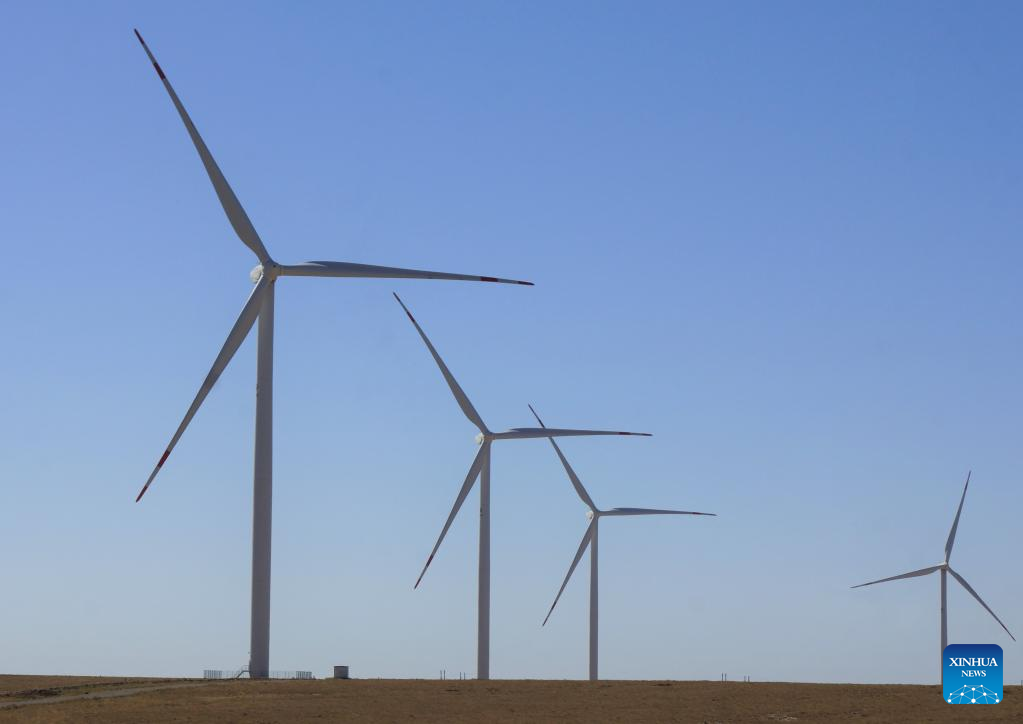

A staff member monitors the operation of wind turbines at the control center of the 100-MW Zhanatas wind farm near the city of Zhanatas in the Zhambyl Region, Kazakhstan, Sept. 13, 2022.
The wind farm, with 40 wind turbines and a combined capacity of 100 megawatts, is jointly-held by China Power International Holding and Visor Kazakhstan. As central Asia's largest wind farm built by a Chinese firm, the wind farm was put into operation in 2021, capable of generating 350 million kilowatt-hours of electricity annually. It alleviates the power shortage in southern Kazakhstan and has brought the once quiet industrial city back to life. Compared with a thermal power plant with the same capacity, this wind farm is expected to save about 110,000 tons of standard coal per year and reduce greenhouse gas emissions. (Photo by Dmitry Vasilenko/Xinhua)

Photo taken on Sept. 13, 2022 shows some wind turbines at the 100-MW Zhanatas wind farm near the city of Zhanatas in the Zhambyl Region, Kazakhstan.
The wind farm, with 40 wind turbines and a combined capacity of 100 megawatts, is jointly-held by China Power International Holding and Visor Kazakhstan. As central Asia's largest wind farm built by a Chinese firm, the wind farm was put into operation in 2021, capable of generating 350 million kilowatt-hours of electricity annually. It alleviates the power shortage in southern Kazakhstan and has brought the once quiet industrial city back to life. Compared with a thermal power plant with the same capacity, this wind farm is expected to save about 110,000 tons of standard coal per year and reduce greenhouse gas emissions. (Photo by Dmitry Vasilenko/Xinhua)

Photo taken on Sept. 13, 2022 shows some wind turbines at the 100-MW Zhanatas wind farm near the city of Zhanatas in the Zhambyl Region, Kazakhstan.
The wind farm, with 40 wind turbines and a combined capacity of 100 megawatts, is jointly-held by China Power International Holding and Visor Kazakhstan. As central Asia's largest wind farm built by a Chinese firm, the wind farm was put into operation in 2021, capable of generating 350 million kilowatt-hours of electricity annually. It alleviates the power shortage in southern Kazakhstan and has brought the once quiet industrial city back to life. Compared with a thermal power plant with the same capacity, this wind farm is expected to save about 110,000 tons of standard coal per year and reduce greenhouse gas emissions. (Photo by Dmitry Vasilenko/Xinhua)

Photo taken on Sept. 13, 2022 shows a view of the control center of the 100-MW Zhanatas wind farm near the city of Zhanatas in the Zhambyl Region, Kazakhstan.
The wind farm, with 40 wind turbines and a combined capacity of 100 megawatts, is jointly-held by China Power International Holding and Visor Kazakhstan. As central Asia's largest wind farm built by a Chinese firm, the wind farm was put into operation in 2021, capable of generating 350 million kilowatt-hours of electricity annually. It alleviates the power shortage in southern Kazakhstan and has brought the once quiet industrial city back to life. Compared with a thermal power plant with the same capacity, this wind farm is expected to save about 110,000 tons of standard coal per year and reduce greenhouse gas emissions. (Photo by Dmitry Vasilenko/Xinhua)

Photo taken on Sept. 13, 2022 shows the entrance to the 100-MW Zhanatas wind farm near the city of Zhanatas in the Zhambyl Region, Kazakhstan.
The wind farm, with 40 wind turbines and a combined capacity of 100 megawatts, is jointly-held by China Power International Holding and Visor Kazakhstan. As central Asia's largest wind farm built by a Chinese firm, the wind farm was put into operation in 2021, capable of generating 350 million kilowatt-hours of electricity annually. It alleviates the power shortage in southern Kazakhstan and has brought the once quiet industrial city back to life. Compared with a thermal power plant with the same capacity, this wind farm is expected to save about 110,000 tons of standard coal per year and reduce greenhouse gas emissions. (Photo by Dmitry Vasilenko/Xinhua)
今年1月,新冠疫情突然而至。为了防止疫情扩散,我国采取了史无前例的交通阻断及人流限制措施,这也为我国农业农村经济发展带来了巨大挑战。
